Effects of Hot Pixels on Pixel Performance on Backside Illuminated Complementary Metal Oxide Semiconductor (CMOS) Image Sensors
Abstract
:1. Introduction
2. Experiment Details
2.1. Device Information
2.2. Irradiation and Measurement
3. Results and Discussion
3.1. Hot Pixel Selection
3.2. Pixel Performance at Light Environments
3.3. Pixel Performance in Dark Environments
4. Conclusions
Author Contributions
Funding
Institutional Review Board Statement
Informed Consent Statement
Data Availability Statement
Conflicts of Interest
References
- Soman, M.R.; Allanwood, E.A.H.; Holland, A.D.; Stefanov, K.; Pratlong, J.; Leese, M.; Gow, J.P.D.; Smith, R. Electro-optic and radiation damage performance of the CIS115, an imaging sensor for the JANUS optical camera on-board JUICE. In High Energy, Optical, and Infrared Detectors for Astronomy Vii; SPIE: Edinburgh, UK, 2016; Volume 9915. [Google Scholar]
- Minoglou, K.; De Munck, K.; Tezcan, D.S.; Van Hoof, C.; De Moor, P.; Bogaerts, J.; Veltroni, I.F. Backside illuminated thinned CMOS image sensors for space imaging. In Proceedings of the Sensors, 2008 IEEE, Lecce, Italy, 26–29 October 2008; IEEE: Piscataway, NJ, USA, 2008. [Google Scholar]
- Vu, P.; Fowler, B.; Balicki, J.; Liu, C.; Mims, S.; Do, H.; Li, W.; Appelbaum, J.; Venus, H.; Schwarzer, H.; et al. High-speed BSI CMOS image sensor for space applications with 1.1Me-full well capacity and 28e-rms read noise. In Proceedings of the 2nd Workshop CMOS Image Sensors for High Performance Applications, Toulouse, France, 6–7 December 2011. [Google Scholar]
- Polidan, E.J.; Waczynski, A.; Marshall, P.W.; Johnson, S.D.; Marshall, C.J.; Reed, R.A.; Kimble, R.A.; Delo, G.; Schlossberg, D.; Russell, A.M.; et al. Hot pixel behavior in WFC3 CCD detectors irradiated under operational conditions. Proc. SPIE 2004, 5167, 258–269. [Google Scholar]
- Penquer, A.; Boutillier, M.; Rolland, G.; Gilard, O.; Fougnie, B.; Porez, F. Analysis of CCD Dark Current Degradation in Orbit. IEEE Trans. Nucl. Sci. 2009, 56, 2142–2148. [Google Scholar] [CrossRef]
- Weiler, F.; Kanitz, T.; Wernham, D.; Rennie, M.; Huber, D.; Schillinger, M.; Saint-Pe, O.; Bell, R.; Parrinello, T.; Reitebuch, O. Characterization of dark current signal measurements of the ACCDs used on board the Aeolus satellite. Atmos. Meas. Tech. 2021, 14, 5153–5177. [Google Scholar] [CrossRef]
- Hopkinson, G.R.; Dale, C.J.; Marshall, P.W. Proton effects in charge-coupled devices. IEEE Trans. Nucl. Sci. 1996, 43, 614–627. [Google Scholar] [CrossRef]
- Hopkinson, G.R.; Mohammadzdeh, A. Radiation effects in charge-coupled device (CCD) imagers and cmos active pixel sensors. Int. J. High Speed Electron. Syst. 2004, 14, 419–443. [Google Scholar] [CrossRef]
- Virmontois, C.; Goiffon, V.; Corbiere, F.; Magnan, P.; Girard, S.; Bardoux, A. Displacement Damage Effects in Pinned Photodiode CMOS Image Sensors. IEEE Trans. Nucl. Sci. 2012, 59, 2872–2877. [Google Scholar] [CrossRef]
- Palko, J.W.; Srour, J.R. Amorphous Inclusions in Irradiated Silicon and Their Effects on Material and Device Properties. IEEE Trans. Nucl. Sci. 2008, 55, 2992–2999. [Google Scholar] [CrossRef]
- Bogaerts, J.; Dierickx, B.; Mertens, R. Enhanced dark current generation in proton-irradiated CMOS active pixel sensors. IEEE Trans. Nucl. Sci. 2002, 49, 1513–1521. [Google Scholar] [CrossRef]
- Bogaerts, J.; Dierickx, B.; Mertens, R. Random telegraph signals in a radiation-hardened CMOS active pixel sensor. IEEE Trans. Nucl. Sci. 2002, 49, 249–257. [Google Scholar] [CrossRef]
- Sze, S. Semiconductor Devices: Physics and Technology; Wiley: Hoboken, NJ, USA, 1985. [Google Scholar]
- Goiffon, V.; Estribeau, M.; Cervantes, P.; Molina, R.; Gaillardin, M.; Magnan, P. Influence of Transfer Gate Design and Bias on the Radiation Hardness of Pinned Photodiode CMOS Image Sensors. IEEE Trans. Nucl. Sci. 2014, 61, 3290–3301. [Google Scholar] [CrossRef]
- Goiffon, V.; Hopkinson, G.R.; Magnan, P.; Bernard, F.; Rolland, G.; Saint-Pe, O. Multilevel RTS in Proton Irradiated CMOS Image Sensors Manufactured in a Deep Submicron Technology. IEEE Trans. Nucl. Sci. 2009, 56, 2132–2141. [Google Scholar] [CrossRef] [Green Version]
- Srour, J.R.; Lo, D.H. Universal damage factor for radiation-induced dark current in silicon devices. IEEE Trans. Nucl. Sci. 2000, 47, 2451–2459. [Google Scholar] [CrossRef]
- Liu, B.; Li, Y.; Wen, L.; Zhao, J.; Zhou, D.; Feng, J.; Guo, Q. Displacement Damage Effects in Backside Illuminated CMOS Image Sensors. IEEE Trans. Electron Devices 2022, 69, 2907–2914. [Google Scholar] [CrossRef]
- Pelamatti, A.; Goiffon, V.; Estribeau, M.; Cervantes, P.; Magnan, P. Estimation and Modeling of the Full Well Capacity in Pinned Photodiode CMOS Image Sensors. IEEE Electron Device Lett. 2013, 34, 900–902. [Google Scholar] [CrossRef] [Green Version]
- Hopkinson, G.R.; Goodman, T.M.; Prince, S.R. Charge-to-Voltage Conversion Factor (CVF) and Conversion Gain. In A Guide to Use and Calibration of Detector Array Equipment; SPIE: Edinburgh, UK, 2004. [Google Scholar]
- Belloir, J.-M.; Lincelles, J.-B.; Pelamatti, A.; Durnez, C.; Goiffon, V.; Virmontois, C.; Paillet, P.; Magnan, P.; Gilard, O. Dark Current Blooming in Pinned Photodiode CMOS Image Sensors. IEEE Trans. Electron Devices 2017, 64, 1161–1166. [Google Scholar] [CrossRef] [Green Version]
- Hopkins, I.H.; Hopkinson, G.R. Random Telegraph Signals from Proton-Irradiated CCDs. IEEE Trans. Nucl. Sci. 1993, 40, 1567–1574. [Google Scholar] [CrossRef]
- Virmontois, C.; Goiffon, V.; Robbins, M.S.; Tauziede, L.; Geoffray, H.; Raine, M.; Girard, S.; Gilard, O.; Magnan, P.; Bardoux, A. Dark Current Random Telegraph Signals in Solid-State Image Sensors. IEEE Trans. Nucl. Sci. 2013, 60, 4323–4331. [Google Scholar] [CrossRef] [Green Version]
- Smith, D.R.; Holland, A.D.; Hutchinson, I.B. Random telegraph signals in charge coupled devices. Nucl. Instrum. Methods Phys. Res. Sect. A-Accel. Spectrom. Detect. Assoc. Equip. 2004, 530, 521–535. [Google Scholar] [CrossRef] [Green Version]
- Virmontois, C.; Goiffon, V.; Magnan, P.; Saint-Pe, O.; Girard, S.; Petit, S.; Rolland, G.; Bardoux, A. Total Ionizing Dose Versus Displacement Damage Dose Induced Dark Current Random Telegraph Signals in CMOS Image Sensors. IEEE Trans. Nucl. Sci. 2011, 58, 3085–3094. [Google Scholar] [CrossRef]
- Hopkinson, G.R. Radiation-induced dark current increases in CCDs. In Proceedings of the RADECS 93. Second European Conference on Radiation and Its Effects on Components and Systems, Saint Malo, France, 13–16 September 1993. [Google Scholar]
- Belloir, J.M.; Goiffon, V.; Virmontois, C.; Paillet, P.; Raine, M.; Molina, R.; Durnez, C.; Gilard, O.; Magnan, P. Dark Current Spectroscopy in Neutron, Proton and Ion Irradiated CMOS Image Sensors: From Point Defects to Clusters. IEEE Trans. Nucl. Sci. 2017, 64, 27–37. [Google Scholar] [CrossRef]
- Le Roch, A.; Virmontois, C.; Goiffon, V.; Tauziede, L.; Belloir, J.M.; Durnez, C.; Magnan, P. Radiation-Induced Defects in 8T-CMOS Global Shutter Image Sensor for Space Applications. IEEE Trans. Nucl. Sci. 2018, 65, 1645–1653. [Google Scholar] [CrossRef] [Green Version]
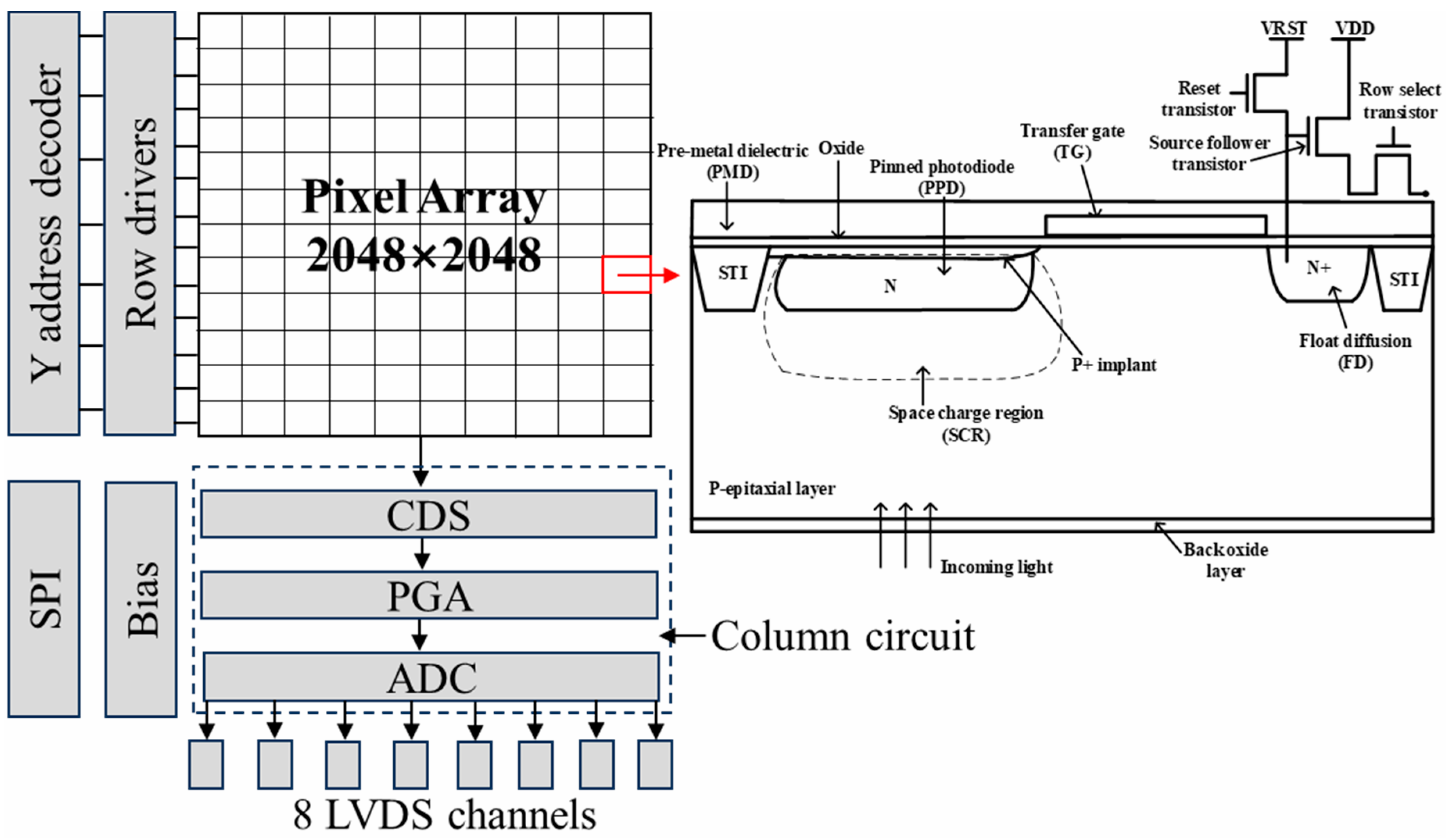

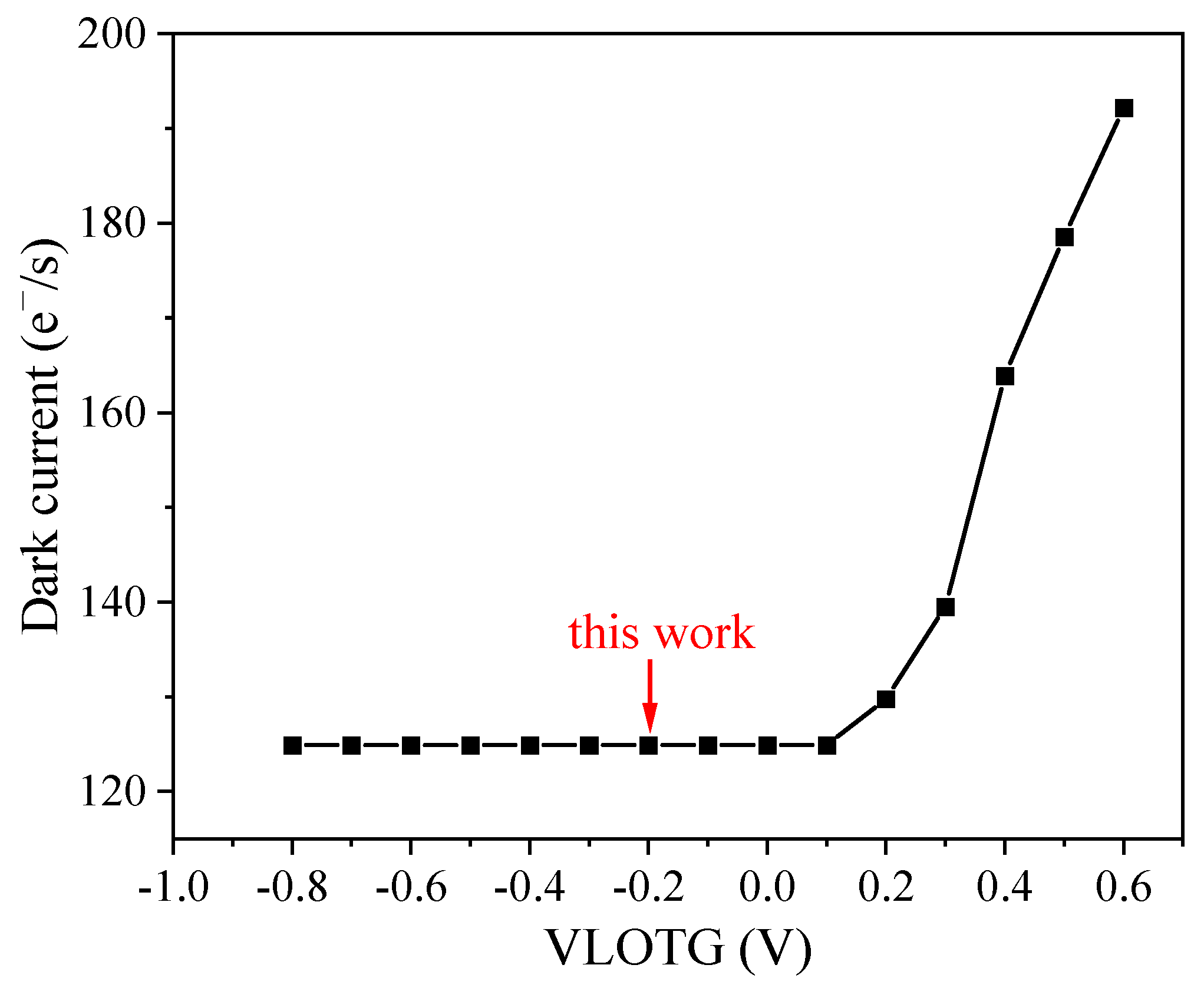


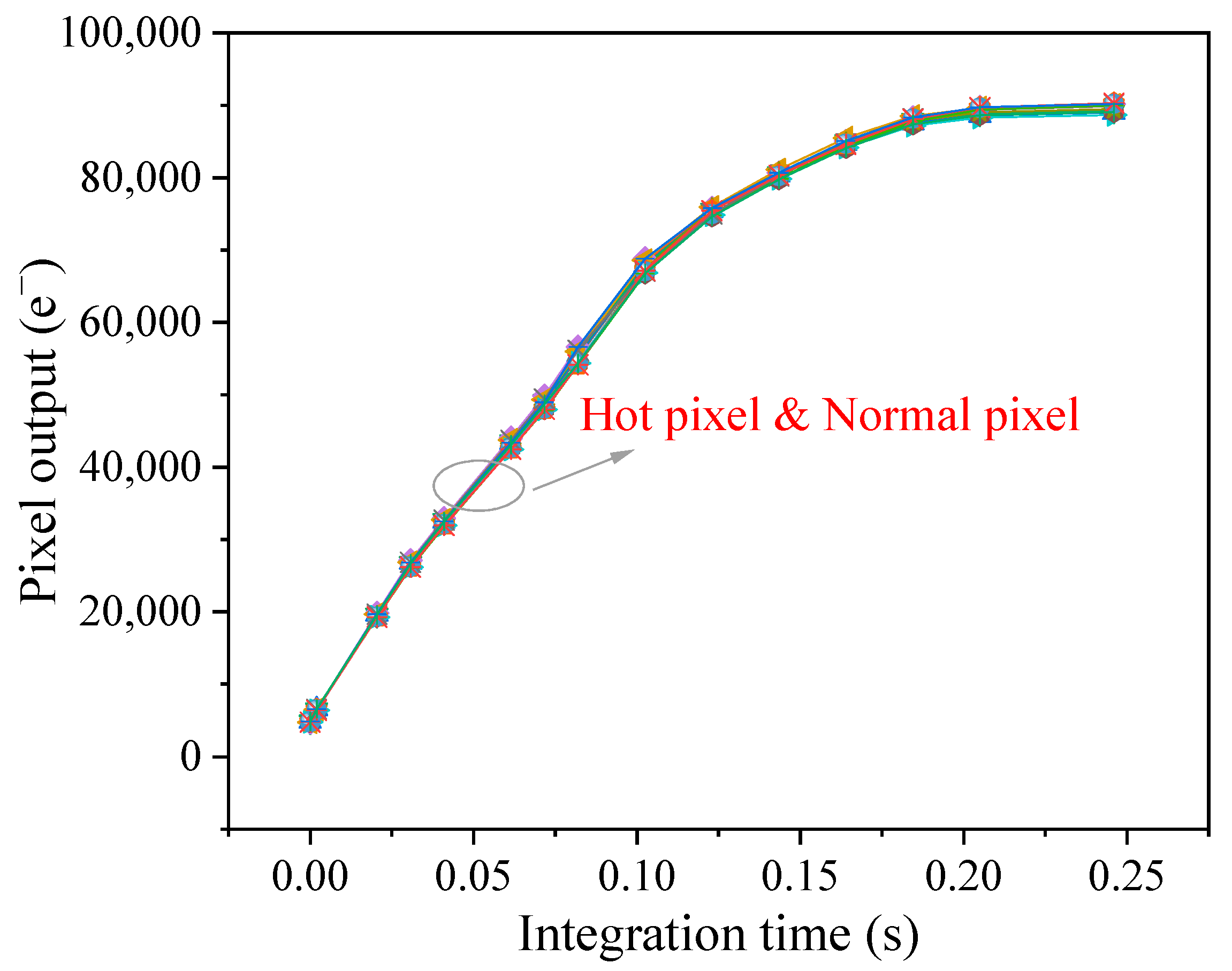
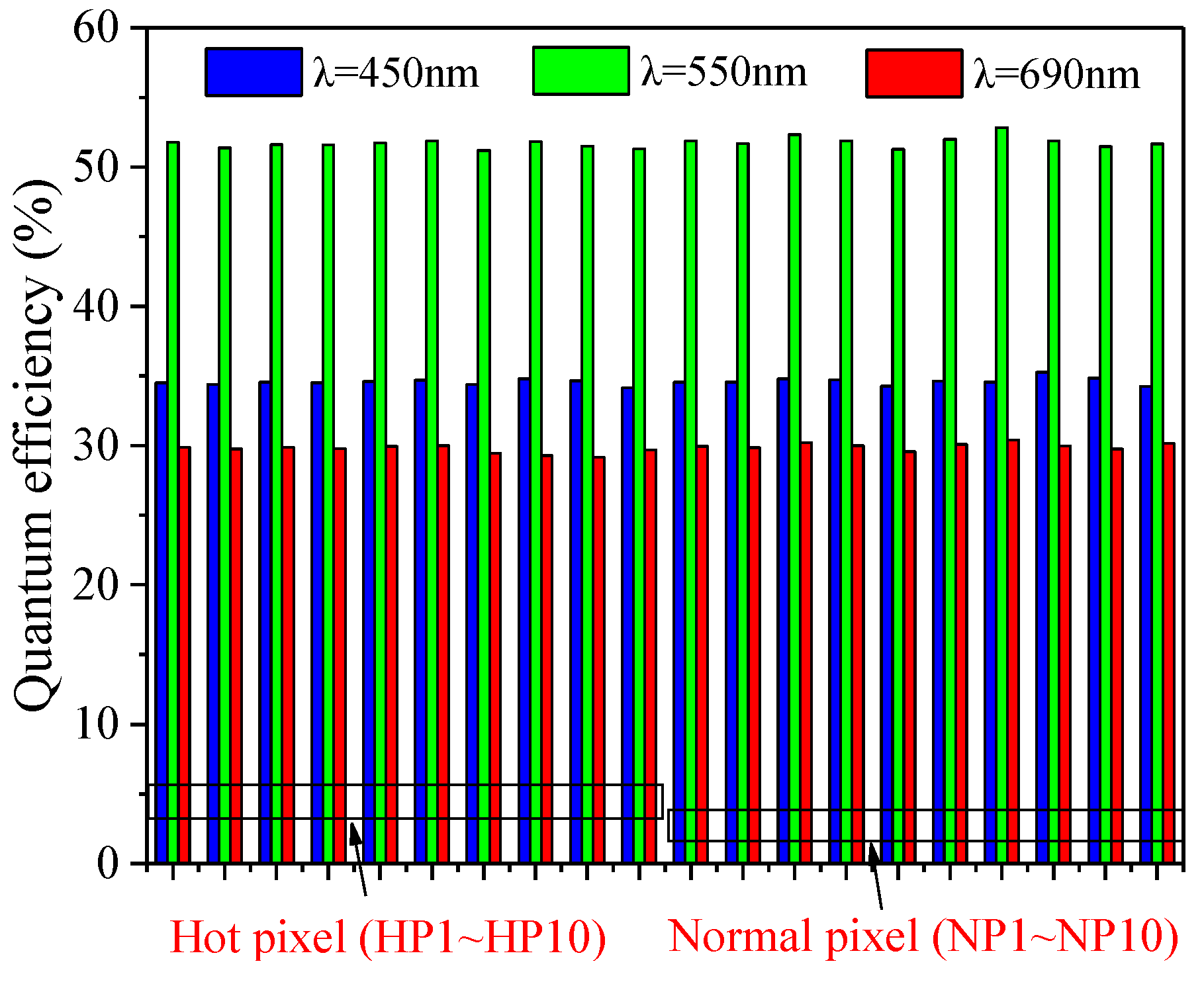
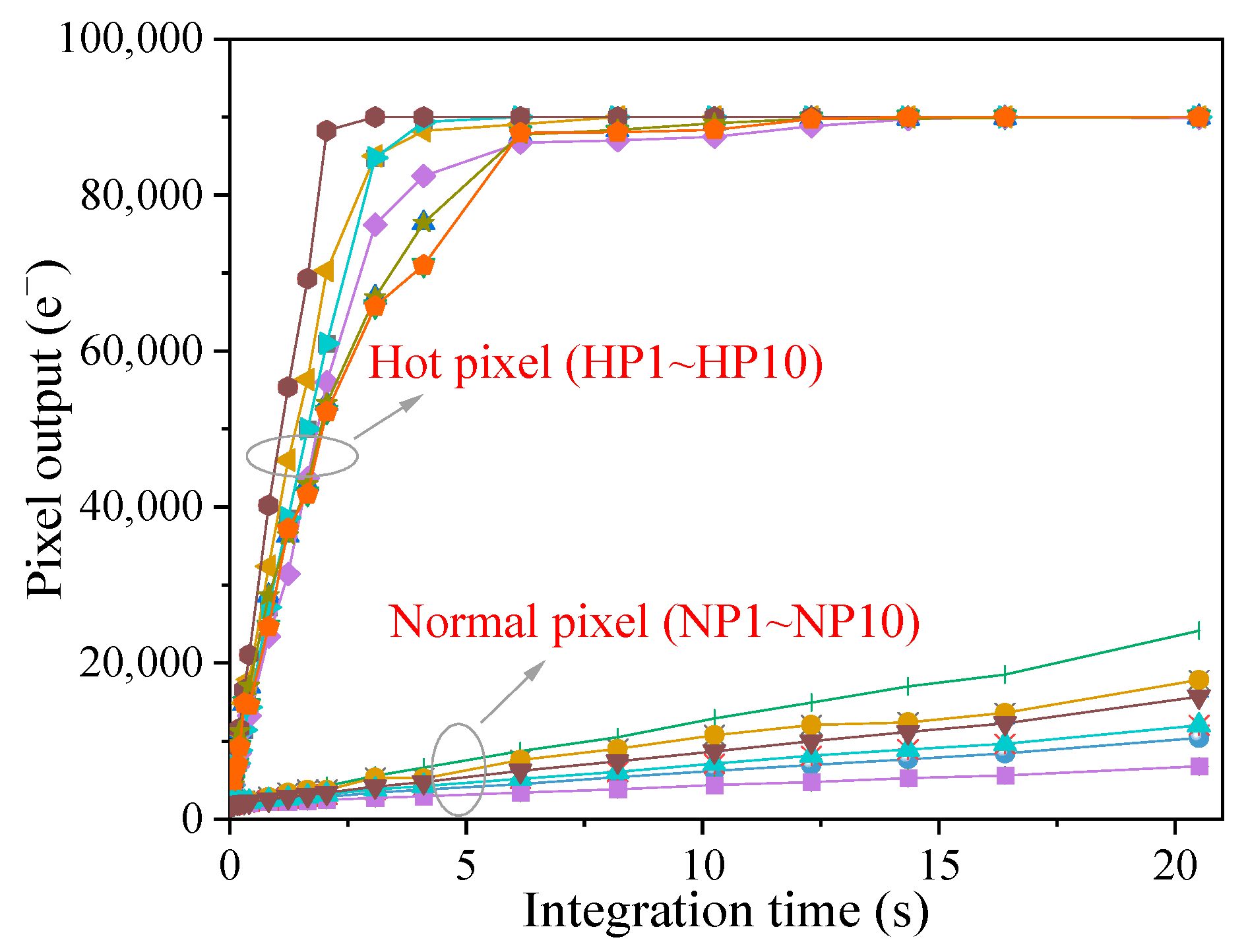



| Hot Pixel | Dark Current (e−/s) | Location | Normal Pixel | Dark Current (e−/s) | Location |
|---|---|---|---|---|---|
| HP1 | 8549.5 | [299, 276] | NP1 | 309.9 | [155, 95] |
| HP2 | 8360.4 | [119, 140] | NP2 | 347.3 | [3, 81] |
| HP3 | 8254.9 | [143, 127] | NP3 | 358.2 | [483, 225] |
| HP4 | 8149.5 | [143, 191] | NP4 | 375.8 | [597, 138] |
| HP5 | 7936.3 | [208, 151] | NP5 | 415.4 | [63, 527] |
| HP6 | 7907.7 | [271, 24] | NP6 | 433.0 | [201, 47] |
| HP7 | 7696.7 | [158, 86] | NP7 | 444.0 | [334, 206] |
| HP8 | 7582.4 | [288, 246] | NP8 | 461.5 | [246, 189] |
| HP9 | 7575.8 | [263, 218] | NP9 | 496.7 | [634, 301] |
| HP10 | 7547.3 | [129, 75] | NP10 | 512.1 | [48, 190] |
Disclaimer/Publisher’s Note: The statements, opinions and data contained in all publications are solely those of the individual author(s) and contributor(s) and not of MDPI and/or the editor(s). MDPI and/or the editor(s) disclaim responsibility for any injury to people or property resulting from any ideas, methods, instructions or products referred to in the content. |
© 2023 by the authors. Licensee MDPI, Basel, Switzerland. This article is an open access article distributed under the terms and conditions of the Creative Commons Attribution (CC BY) license (https://creativecommons.org/licenses/by/4.0/).
Share and Cite
Liu, B.; Li, Y.; Wen, L.; Zhang, X.; Guo, Q. Effects of Hot Pixels on Pixel Performance on Backside Illuminated Complementary Metal Oxide Semiconductor (CMOS) Image Sensors. Sensors 2023, 23, 6159. https://doi.org/10.3390/s23136159
Liu B, Li Y, Wen L, Zhang X, Guo Q. Effects of Hot Pixels on Pixel Performance on Backside Illuminated Complementary Metal Oxide Semiconductor (CMOS) Image Sensors. Sensors. 2023; 23(13):6159. https://doi.org/10.3390/s23136159
Chicago/Turabian StyleLiu, Bingkai, Yudong Li, Lin Wen, Xiang Zhang, and Qi Guo. 2023. "Effects of Hot Pixels on Pixel Performance on Backside Illuminated Complementary Metal Oxide Semiconductor (CMOS) Image Sensors" Sensors 23, no. 13: 6159. https://doi.org/10.3390/s23136159




